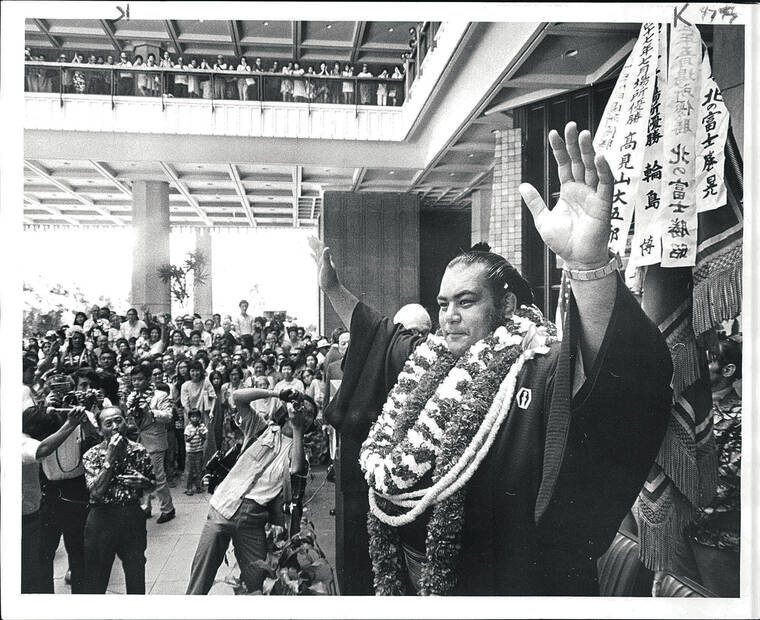
Mahalo for supporting Honolulu Star-Advertiser. Enjoy this free story!
TOKYO >> As the Sumida River flows through central Tokyo during his morning embankment walks, so, too, do the vivid memories of a groundbreaking career in sumo for Jesse Kuhaulua these days.
Kuhaulua, who will be 80 in June, recently moved into a comfortable senior home that overlooks the sumo heartland. It is seemingly a few ritual salt throws away from the site of the former Kuramae Kokugikan, the arena where he fought his 1,653rd and last match in 1984 under the ring name Takamiyama.
A subway stop or two away are the site of the old Takasago stable — where he learned and polished the techniques that would shake to the sports’ feudal underpinnings — and the building that housed his own Azumazeki stable — where he coached sumo’s first foreign-born yokozuna (grand champion), the late Chad Rowan (Akebono).
“So many memories along the way,” Kuhaulua said in a recent interview. “Sometimes it is hard to imagine it all. But it is something that I’m very proud of and thankful for.”
There is a lot to flash back on these days, some of the memories no doubt prompted by his circa 1970s black and white cover photo on the annual sumo almanac “Ozumo Rikishi Meikan” appearing on bookstore shelves in Japan.
The compendium of sumotori history since the 1860s pays tribute to the remarkable revolution that Kuhaulua sparked upon his arrival from Happy Valley, Maui, 60 years ago sparked. In its pages are several who followed him from Hawaii and into the top division (makuuchi) in the 1980s and ’90s, Salevaa Atisanoe (Konishiki), Fiamalu Penitani (Musashimaru), George Kalima (Yamato) and Akebono, who died last week.
They, among the dozens who came in Kuhaulua’s size 17 footsteps, reached the top salaried levels and competed on the highest stages of sumo.
Their success is a considerable point of pride, Kuhaulua said. “You see the work they have done to get where they got and you feel good about that, happy for their success.”
There had been a small handful of foreign-born sumo aspirants since the 1930s. But Kuhaulua, the former Baldwin High football player, was the first to make such a sudden or enduring impact in a career that spanned nearly 40 years in the ring and 60 years in the sport.
There is a saying in sumo that “treasure is buried in the dohyo (ring)” for those with the grit and ability to unearth it, and Kuhaulua found it in storybook fashion from an arduous beginning.
He freshly recalls the triumphs that included 12 upsets of grand champions and victory parades in two countries — but he also remembers riding Tokyo’s Yamanote transit line in circles for hours by himself in initial loneliness. Despite the passage of the years, there is a grimace on his face when recalling the pain of being whacked with a bamboo pole by coaches and veteran sumotori when he struggled in practice.
From someone initially too shy to put on the thin loincloth mawashi in public upon reaching Japan in 1964, Kuhaulua rose to an unimagined prominence by the time he retired in 1984.
Along the way, Kuhaulua earned a hard-won place in the lore of the centuries-old national sport of Japan with a handful of ironman records in a lucrative career that included 1,231 consecutive bouts in the makuuchi division and a spot in the hearts of its fans as well.
Even behind a flowing gray beard that did not exist when he competed, Kuhaulua’s 6-foot-3, 300-plus pound frame and distinctive raspy voice sometimes bring a jolting recognition and slight bow from passersby of a certain age on his 90-minute morning walks.
The Godfather-like voice was a result of a powerful hand thrust to the larynx during an early-career practice session. Initially, Kuhaulua put off the recommended surgery so as not to disrupt training and fall back in the ranks. But, eventually, it emerged as a trademark, one of several that would help set him apart from other sumotori.
“It became part of me,” said Kuhaulua, who elected not to have the surgery even after retiring.
When Kuhaulua made a quick ascent in the sumo ranks and became the first foreigner to win the Emperor’s Cup, symbolic of a tournament championship, in 1972, it aroused some hostility and fear among conservative elements and purists.
After a Dutchman won a gold medal in judo in the 1964 Tokyo Olympics, suddenly domination in Japan’s other kokugi (national sport), sumo, seemed under threat. And a headline that humid July day in Nagoya, blared “National Sport in Danger” following Kuhaulua’s 13-2 showing.
But Kuhaulua’s determined work ethic, displays of heart-felt emotion and “Go for Broke” style, as emblematized on the ceremonial kesho mawashi apron donated by the 442nd Veterans Club, won over fans used to stone-faced stoicism and monosyllabic utterances from other sumotori.
A playful wink, frequent smile, earnest exuberance and down-to-earth humility quickly drew people to him.
“His shikona (ring name) was Takamiyama, but fans felt a closeness and often called him just ‘Jesse,’” said Toshiharu Kyosu, who chronicled Kuhaulua’s career from 1966 for Japan’s Kyodo News Service and co-authored the current annual in bookstores.
Even at the senior facility where Kuhaulua takes exercise classes to rehab following double knee replacements, there is a buoyant joy from his classmates when he enters the room for the afternoon workout. And when he returns a sheepish grin arriving minutes late from an interview, there is laughter.
Such was his popularity that despite the fact that he did not climb past sekiwake, sumo’s third-highest rank, Kuhaulua was a much sought after pitchman for TV and print commercials for everything from futons to electronic entertainment devices, opening lucrative frontiers for sumotori.
These days Kuhaulua says he rarely watches the top division sumo matches, preferring to focus on the up and coming prospects.
“I like to see how the younger guys are doing, who is standing out and what the future might look like,” Kuhaulua said.
He also said he yearns to see what Hawaii could contribute to a newer generation so far dominated by the wave of Mongolians who followed Hawaii’s sumotori.
The sport has been without a Hawaii sumotori since a nephew of Musashimaru’s, Mamu Penitani, retired following back issues in 2019. The younger Penitani, who competed as Musashikuni, reached the sandanme division.
Earlier this year, another nephew, Daniel, a Waianae High graduate, took up training in preparation for admittance into the sport, Musashimaru said.
“I hope he can make it,” Kuhaulua said. “If you really work hard and take advantage of a few breaks, you can have a very good life through sumo.”
All around Kuhaulua there is enduring testament to that.
HAWAII’S TOP SUMOTORI
Since the pioneering Jesse Kuhaulua broke into sumo 60 years ago, 23 prospects from Hawaii have followed in his footsteps, four of whom achieved a ranking in the sport’s top division, makuuchi, during their careers.
Name….Hometown… Sumo name… Rank …Career … Championships.
Jesse Kuhaulua Maui Takamiyama Sekiwake 1964 – ‘84 (1).
Salevaa Atisanoe Nanakuli Konishiki Ozeki 1982-‘97 (3).
Chad Rowan Waimanalo Akebono Yokozuna. 1988-‘01 (11).
Fiamalu Penitani Waianae Musashimaru Yokozuna 1989-‘03 (12).
George Kalima Waimanalo Yamato Maegashira 12 1990-98 (0).
—-
Ranks in Makuuchi, the highest of sumo’s six divisions.
1. Yokozuna
2. Ozeki
3. Sekiwake
4. Komusubi
5. Maegashira
Read More: World News | Entertainment News | Celeb News
Star Ads





